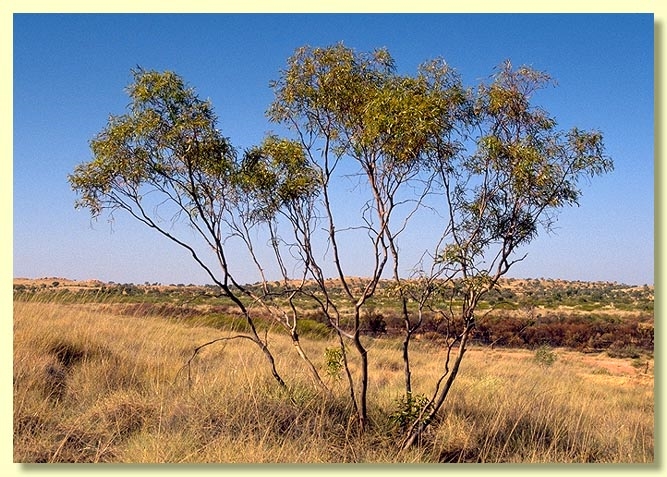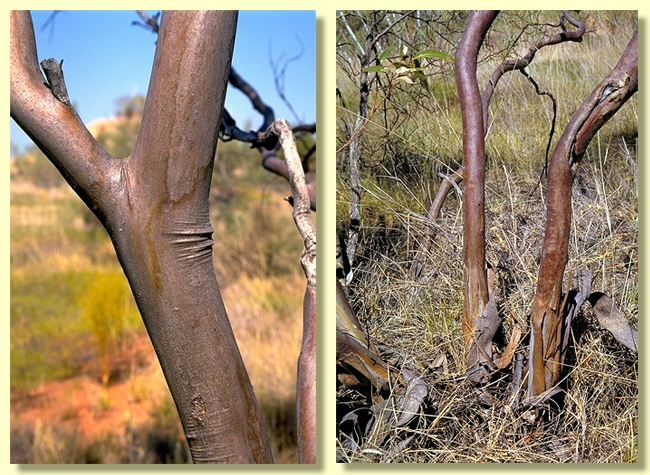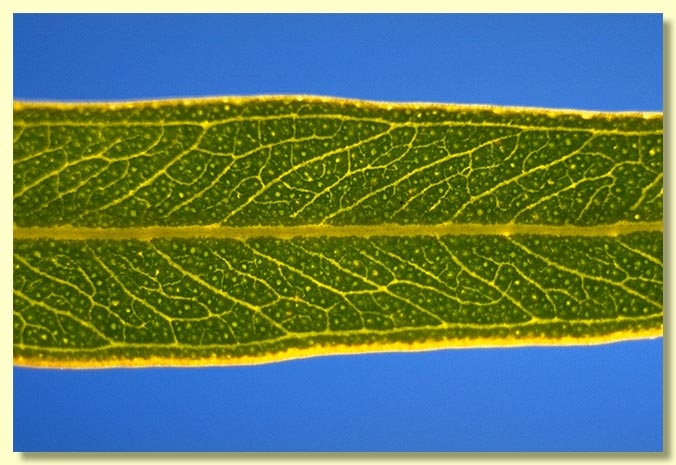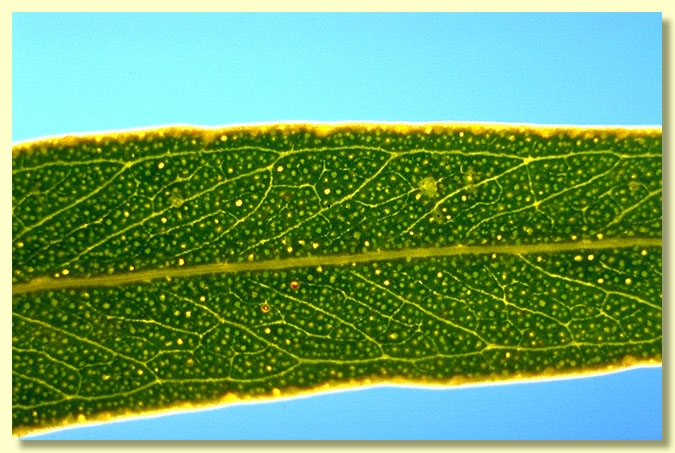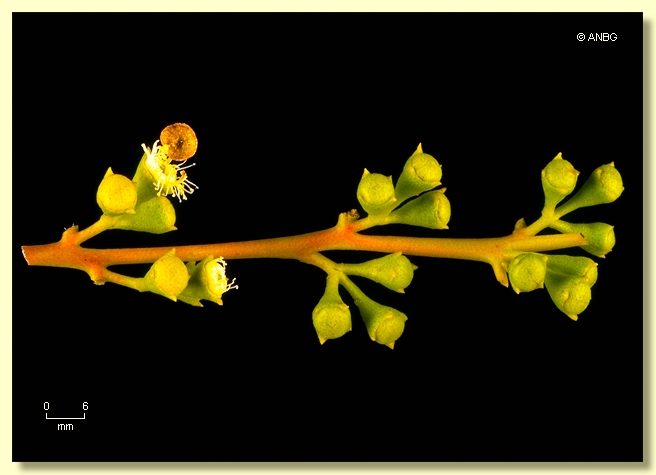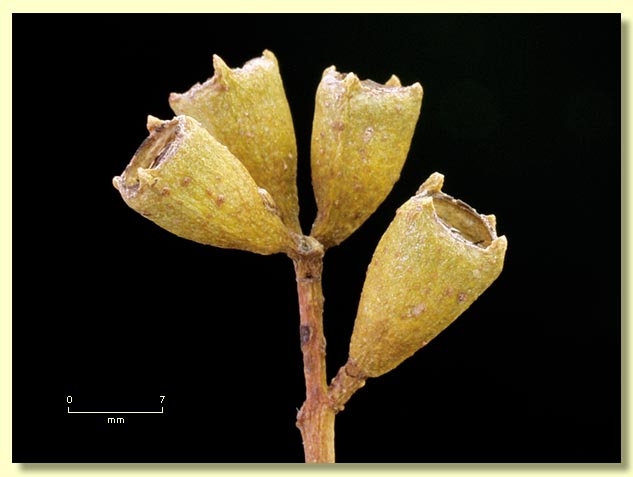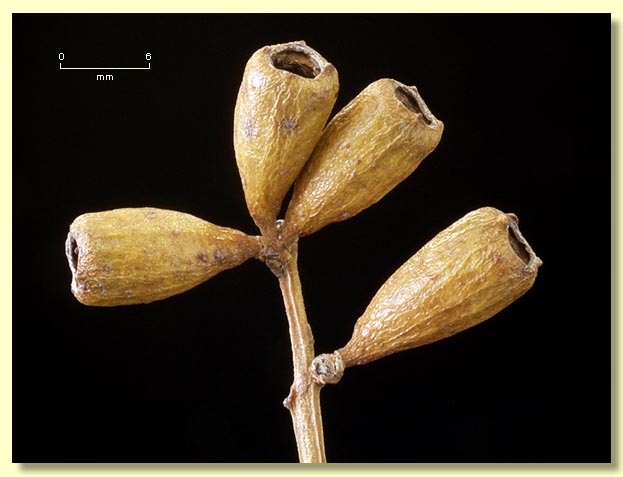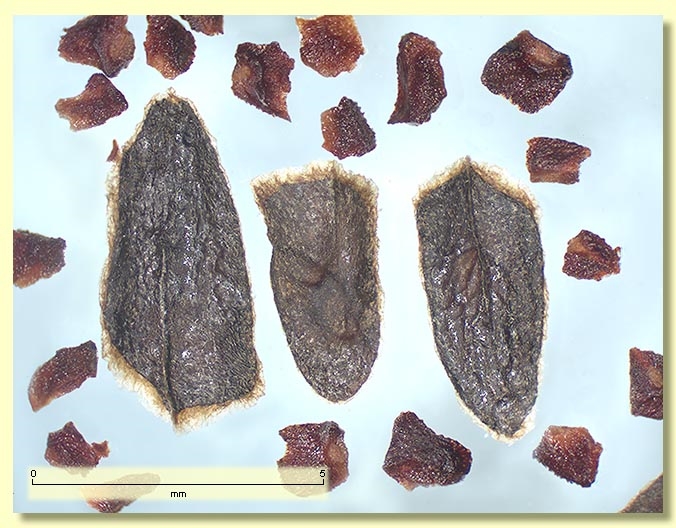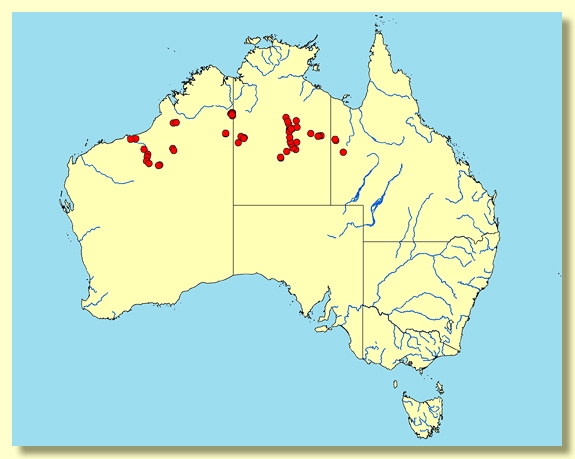Euclid - Online edition
Eucalyptus odontocarpa
Eucalyptus | Eudesmia | Limbatae | Heteropterae | Patelliformes
Small mallee to 4 m tall. Forming a lignotuber.
Bark usually smooth throughout, grey to brown to coppery, sometimes white to cream to pink, occasionally with a short stocking of pale grey to yellowy-brown rough flaky bark. Branchlets normally non-glaucous, rarely glaucous, with no oil glands in the pith.
Juvenile growth (coppice or field seedlings to 50 cm): stems rounded in cross-section, usually not glaucous, glabrous; juvenile leaves opposite and sessile, ovate to cordate to broadly lanceolate, 3.5–10(13) cm long, 2–5.5(6) cm wide, base usually amplexicaul to truncate to rounded, sometimes connate, apex acute, green, occasionally glaucous, glabrous. Juvenile leaves sometimes persist in the mature crown.
Adult leaves opposite to sub-opposite, petioles 0.5–1.7 cm long; blade narrowly lanceolate to lanceolate, (5.5)9–15(19.5) cm long, 0.5–1.8 cm wide, base tapering to petiole, concolorous, glossy green, side-veins at about 45° to the midrib, tertiary venation sparse to moderate, intramarginal vein present and well removed from the margin, oil glands large and mostly island.
Inflorescence compound terminal or compound axillary to rarely axillary paired, peduncles 0.2–0.5 cm long, buds 3 per umbel, pedicellate (pedicels 0.1–0.2 cm long). Mature buds clavate to pyriform (0.45–0.6 cm long, 0.4–0.6 cm wide), usually not glaucous, outer perianth whorl minutely sepaline, inner whorl operculate, operculum rounded to flattened, stamens grouped in four clusters (difficult to see once stamens have fully opened), usually inflexed but occasionally with outer stamens more or less erect, anthers oblong, versatile, dorsifixed, dehiscing by longitudinal slits (non-confluent), style long, rarely short, stigma tapered, locules usually 3 or 4, the ovules usually arranged in 4 distinct vertical rows on the placentae or with four vertical ovule rows near the top of the ovary and then two rows below that, or occasionally the arrangement indistinct. Flowers whitish.
Fruit sessile to shortly pedicellate (pedicels 0–0.3 cm long), cylindrical to barrel-shaped to cup-shaped to obconical, 0.7–1.4 cm long, 0.5–0.7 cm wide, usually 4-angled with 4 conspicuous teeth at the rim, not glaucous, disc vertically descending, valves 3 or 4, enclosed.
Seeds dull grey, flattened and often keeled on the dorsal surface, a small translucent flange around the edge of the seed, 4–6 mm long, surface smooth, hilum ventral.
Cultivated seedlings (measured at node 10): cotyledons reniform; stems round in cross-section, glabrous, leaves sessile, opposite, ovate to cordate, 3.5–6 (8) cm long, 2.5–5 cm wide, glaucous to dull green, margins entire, apex broadly acute to rounded, base usually connate, rarely amplexicaul, lamina glabrous.
Flowering has been recorded in April, June, July and August.
A mallee widespread across inland northern Australia from near Goldsworthy, east of Port Hedland in Western Australia eastwards through Western Australia and the Northern Territory to the Mt Isa district in north-western Queensland. It is characterised by the small mallee habit, the smooth grey to brown to coppery bark, the narrow lanceolate, glossy adult leaves and the fruit with four small teeth positioned on the top of the rim.
Eucalyptus odontocarpa belongs in Eucalyptus subgenus Eudesmia because of the combination of cotyledons reniform in shape and folded and clasping in embryo, buds with the calyx either fused to the corolla and evident as four small teeth at the apex of the bud or with the calyx free and evident as four small teeth around the midline of the bud, and stamens often arranged in four bundles. Within subgenus Eudesmia, E. odontocarpa belongs in the section Limbatae, series Heteropterae, subseries Patelliformes and is distinctive because of its flattened seeds with dorsal keel and partial marginal flange, buds with minute free sepals around the midline of the bud, sessile or connate glabrous seedling and juvenile growth, and its lack of oil glands in the pith of the branchlets. This combination of characters is only shared with the closely related E. gamophylla, from central Australia. E. gamophylla is easily separated by its mature crown of opposite, broad, glaucous juvenile leaves, often with connate leaf bases, as opposed to the narrow, glossy lanceolate leaves of E. odontocarpa. Plants intermediate in forms between the two species are common and should be simply referred to as such.
Eucalyptus odontocarpa: Greek odontos-, tooth and carpos, fruit, referring to the four teeth on the rim of the fruit.

